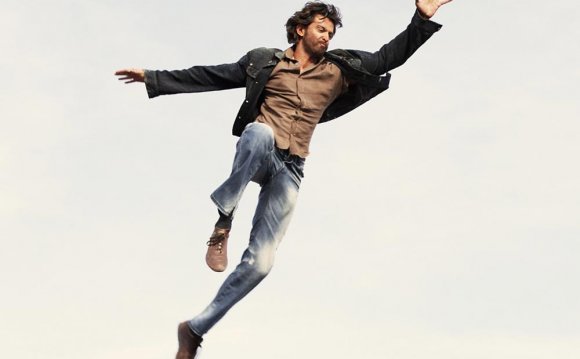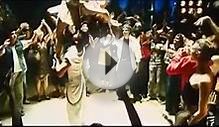
 'All I did was pull it back a little' … Hrithik Roshan and Bárbara Mori in Kites
'All I did was pull it back a little' … Hrithik Roshan and Bárbara Mori in Kites
The clash of civilisations is continuing to bear new fruit. Last Tuesday, the Bollywood film Kites had its world premiere in London; next week sees the release of Kites: The Remix, Hollywood director Brett Ratner's 90-minute, English-language version. Ratner's edit is a tighter, less musical and much more action-oriented product – though he mainly cut, some new scenes were filmed for his version. The aim is to introduce the hazel-eyed, hard-bodied and magnificently bouffanted Hindi superstar Hrithik Roshan to a western audience. It makes Barack Obama's heritage look monotone by comparison.
Ratner has excellent form in breaking foreign stars into the western mainstream, having directed Jackie Chan in the trio of Rush Hour films that made Chan a global commodity. Now, he's risen to the challenge of taking 130 minutes of the biggest-ever budgeted movie in Indian history (rumoured to be £10m), replete with all the songs, comedy, themes and theatricality that an Indian audience expects, and carving out of it a snappy chase movie about star-crossed interracial lovers on the run in the Nevada desert. It's a project the likes of which no western film-maker has undertaken before.
What differences struck Ratner between Bollywood and western cinema when he watched the original? The dancing? The set design? No. "The voices are mixed very highly, with less sound effects in India, " Ratner says. "Hollywood movies, because of the quality of the movie theatres, are mixed with much more sound design." This is the kind of nuanced observation that wouldn't come to most film-watchers straightaway, but it reveals just how technically complicated the disparities are between the two traditions and the complexity of Ratner's task.
"It was a four- or five-month job for him, " said the producer of both movies, Rakesh Roshan (Hrithik's father). The two met at a dinner Ratner gave for the head of Reliance, Kites' distributor, a vast Indian conglomerate whose media arm has been amassing partnerships and acquisitions in Hollywood for the past two years – including a billion-dollar deal with Steven Spielberg's Dreamworks. Having casually invited Ratner to watch his film, Roshan senior then set him the challenge of reshaping it.
"Normally, a movie that is made in a specific country doesn't always translate to the rest of the world. Even Rush Hour, " says Ratner. "If you go to Italy and watch Rush Hour, nobody's laughing." But in the case of Roshan's effort, he says, "I saw what he was going for. He had a vision of making a film that translated internationally." Wanting a breakout hit, Roshan had shot two versions: an Indian one, spoken 80% in Hindi, and one that was a 50-50 split with English, pointed at the lucrative NRI market (Non-Resident Indians – those who have emigrated) and westerners interested in Bollywood.
Roshan's western-looking version and Ratner's experience with Chan made the project less daunting than it might have been. "There were Jackie Chan movies, like Rumble in the Bronx, that were specifically Chinese movies that were dubbed into English, and the music was changed. And that's where I came up with the idea for Rush Hour, " Ratner says. "I'd seen this done before with Chinese films. I didn't invent it."
Ratner is adamant that Bollywood is on the same cusp that Chinese movies were a decade ago. "What does it is the individuals, not just the genre. Hollywood is going to open its doors to Indian cinema because of actors like Hrithik. He really translates to a western culture. He's got the looks, and he's like the John Travolta of Indian cinema. He can sing, he can dance, he can act. He has the international appeal that Jackie Chan has. Hong Kong cinema, Chinese cinema, might not have translated without Jackie Chan. Hrithik is that international star."
In truth, Roshan junior shares a genuinely touching on-screen chemistry with his co-star, the startlingly beautiful Mexican Bárbara Mori. If nothing else, Roshan may be set for stardom in the Latin world, while Mori will almost certainly be adored in India, having all the essential qualities of a Bollywood starlet – fresh-faced beauty, and a chaste but playful spunkiness.
Ratner's edit is stringently cut, with no singing or dance sequences and a much lower emotional note. To find a western movie within a Bollywood one, much of its Indianness has had to be stripped away. "Bollywood films fascinate me, " Ratner says, "because there's four or five genres within one movie and the audience has to deal with that: the transition between comedy, to action, to drama to romance in the turn of a hat. If there's drama, it pushes the envelope to melodrama. If it's comedy, they go to broader comedy. They go really far with what they're doing. And all I did was pull it back a little so it's not over the top, to make the tone more consistent. But I did not change the intention of the film-makers."
YOU MIGHT ALSO LIKE










